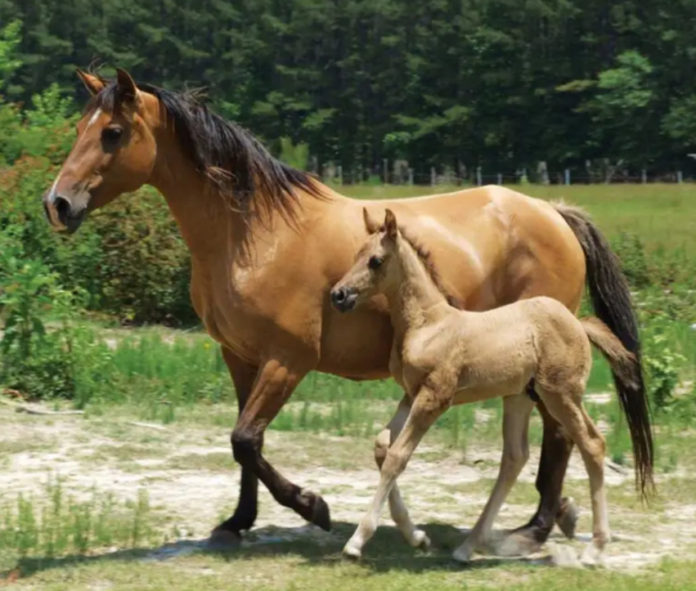
Brought to the US in the 1500’s by the Spanish and found only in South Carolina, Marsh Tacky horses were recognized in 2010 as the South Carolina State Heritage Horse for its long significant and historic connection to the state.
Once considered a common sight throughout the Lowcountry, the Marsh Tacky horse is a unique breeding strain from the Colonial Spanish line, which includes the Spanish Barb and the Carolina Cracker, and has slowly diminished in number.
According to the Carolina Marsh Tacky Association, there are only about 360 documented horses in existence today, making it onto the world’s endangered species list.
“I think that the actual number of full breed Marsh Tackies that are left is closer to about 100,” says Michael Cohen Jr. a six generation Marsh Tacky owner on Hilton Head Island. He said that the island used to be full of Marsh Tackies, but now they have the remaining six.
The disparity in the numbers is indicative of the controversy that exists regarding the horse. Some pure breeds have not been registered and included in the numbers and some horses that are not pure have been. Once you know its specific characteristics, of height and body shape, it’s not hard to tell the difference between a Marsh Tacky and other types of horses. “There are a lot of mixed breed Tackies out there, but you can tell a true breed by its short legs and its narrow chest.” The Marsh Tacky is also unique in its coloring. He goes on to say that they even turn colors from season to season. Some of them can turn from brown to black to reddish; others from black to a deep purple.
Once feral and roaming freely by the hundreds throughout the marshes of the Sea Islands and the Lowcountry, the Marsh Tacky was captured and domesticated. Even in war times, the Marsh Tackies served the southern troops, providing an advantage when mounted on horses that were specifically adapted to the rough and swampy terrain of the region.
Considered a strong work horse with an easy disposition, the Marsh Tacky became a common fixture in Lowcountry fields, especially after the civil war when they became a necessary agricultural and functional element within the Gullah community. The horse was used for all aspects of island living, from transportation to the fields, as well as being used for entertainment during the 1960’s and 1970’s when they were being raced on Hilton Head’s beaches. Technical development, speed and mobility, from tractors to cars and trucks ultimately replaced the need for manual labor and horsepower.
They are work horses that can out work and out pull any other horse. When the weather gets hot, they are ready to work. They don’t eat a lot during the summer. It doesn’t matter what you feed them when it’s hot, their bodies slim down and they are ready to go to work.”
Native Islander – Michael Cohen
Michael recounts a time on the island when there were only three cars and Marsh Tacky horses were the prime mode of transportation. After a season of working in the fields, “during the winter, people would set the horses free to roam the island, but when the warmer weather came, the horses would return home ready to plow when it got hot.”
As rider, Wylie Bell stated in a recent edition of South Carolina Wildlife Magazine, “They don’t panic when they get wrapped up in briars or when they are mired in a bog up to their chest. Like little bulldozers, they push through whatever you ask them to. The Marsh Tacky is made to handle riding in the woods and swamps. They’re smaller and more agile, their hide is thicker, and they have good, solid hooves. Marsh Tackies are not big horses, but they ride big. They have huge hearts and sharp minds, and for people who own them, they’ll be that horse of a lifetime.”
The Marsh Tacky is “more than a horse. It represents a connection to the land and culture for South Carolinians and a way of living, surviving, and adapting to conditions that ultimately became home.”
Caroline Maffry / Equitrekking
The Marsh Tacky is an important part of not only Hilton Head’s history, but of South Carolina’s. The fact that pure bred horses have begun to dwindle in number, is become a sad addition to how the falling away of a major part of Gullah tradition.
The Cohen’s are doing their part to not only care for the horses and keep the tradition alive, but to continue to teach and inform the community about the uniqueness of these beautiful horses. I hope that everyone has the opportunity to see and experience the gentle nature and incredible intelligence that these horses possess. Like all endangered species, knowledge and special attention should be given to help to preserve them, as well as to enable the blood lines to endure and thrive, because it would be a shame to see this precious animal disappear.
Article originally written by Luana M. Graves Sellars and published by LowcountryGullah.com. Used with permission. For more information on Gullah history, culture and the Gullah Geechie Heritage Corridor, visit Lowcountry Gullah here.









